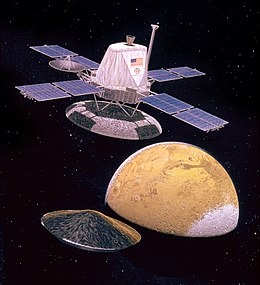Viking orbiter

Artist impression of a Viking orbiter releasing a lander descent capsule
|
|
| Manufacturer | Jet Propulsion Laboratory / Martin Marietta |
|---|---|
| Country of origin | United States |
| Operator | NASA / JPL |
| Applications | Mars orbiter/lander |
| Specifications | |
| Design life | Orbiters: 4 years at Mars Landers: 4-6 years at Mars |
| Launch mass | 3,527 kilograms (7,776 lb) |
| Power | Orbiters: 620 watts (solar array) Lander: 70 watts (two RTG units) |
| Regime | Areocentric |
| Production | |
| Status | Retired |
| Built | 2 |
| Launched | 2 |
| Retired |
Viking 1 orbiter August 17, 1980 Viking 1 lander July 20, 1976 (landing) to November 13, 1982 Viking 2 orbiter July 25, 1978 Viking 2 lander September 3, 1976 (landing) to April 11, 1980 |
| First launch |
Viking 1 August 20, 1975 |
| Last launch |
Viking 2 September 9, 1975 |
The Viking program consisted of a pair of American space probes sent to Mars, Viking 1 and Viking 2. Each spacecraft was composed of two main parts: an orbiter designed to photograph the surface of Mars from orbit, and a lander designed to study the planet from the surface. The orbiters also served as communication relays for the landers once they touched down.
The Viking program grew from NASA's earlier, even more ambitious, Voyager Mars program, which was not related to the successful Voyager deep space probes of the late 1970s. Viking 1 was launched on August 20, 1975, and the second craft, Viking 2, was launched on September 9, 1975, both riding atop Titan III-E rockets with Centaur upper stages. Viking 1 entered Mars orbit on June 19, 1976, with Viking 2 following suit on August 7.
After orbiting Mars for more than a month and returning images used for landing site selection, the orbiters and landers detached; the landers then entered the Martian atmosphere and soft-landed at the sites that had been chosen. The Viking 1 lander touched down on the surface of Mars on July 20, 1976, and was joined by the Viking 2 lander on September 3. The orbiters continued imaging and performing other scientific operations from orbit while the landers deployed instruments on the surface.
The project cost roughly 1 billion USD in 1970s dollars, equivalent to about 11 billion USD in 2016 dollars. It was highly successful and formed most of the body of knowledge about Mars through the late 1990s and early 2000s.
The primary objectives of the two Viking orbiters were to transport the landers to Mars, perform reconnaissance to locate and certify landing sites, act as communications relays for the landers, and to perform their own scientific investigations. Each orbiter, based on the earlier Mariner 9 spacecraft, was an octagon approximately 2.5 m across. The fully fueled orbiter-lander pair had a mass of 3527 kg. After separation and landing, the lander had a mass of about 600 kg and the orbiter 900 kg. The total launch mass was 2328 kg, of which 1445 kg were propellant and attitude control gas. The eight faces of the ring-like structure were 0.4572 m high and were alternately 1.397 and 0.508 m wide. The overall height was 3.29 m from the lander attachment points on the bottom to the launch vehicle attachment points on top. There were 16 modular compartments, 3 on each of the 4 long faces and one on each short face. Four solar panel wings extended from the axis of the orbiter, the distance from tip to tip of two oppositely extended solar panels was 9.75 m.
...
Wikipedia
